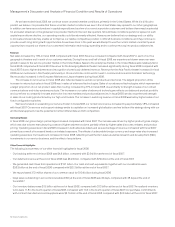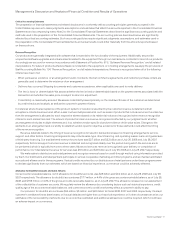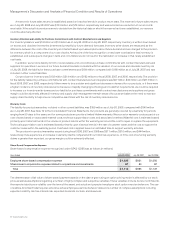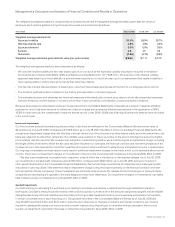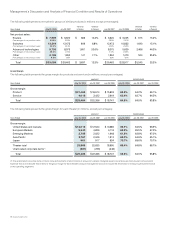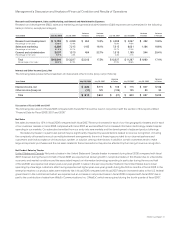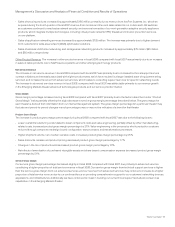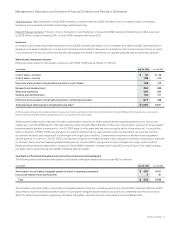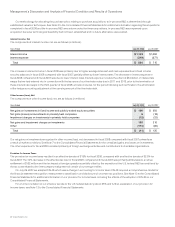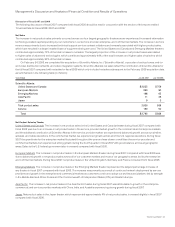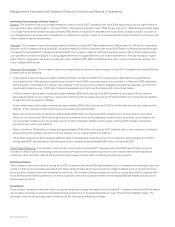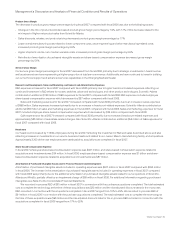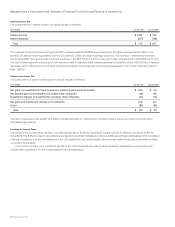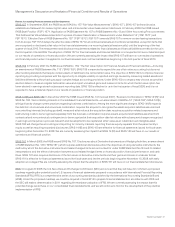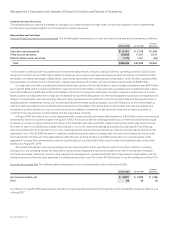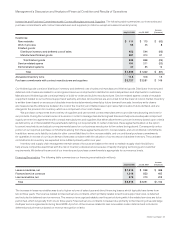Cisco 2008 Annual Report Download - page 25
Download and view the complete annual report
Please find page 25 of the 2008 Cisco annual report below. You can navigate through the pages in the report by either clicking on the pages listed below, or by using the keyword search tool below to find specific information within the annual report.
30 Cisco Systems, Inc.
Management’s Discussion and Analysis of Financial Condition and Results of Operations
Factors That May Impact Net Sales and Gross Margin
Net product sales may continue to be affected by factors including the challenges that are currently affecting economic conditions in the
United States; changes in the geopolitical environment and global economic conditions; competition, including price-focused competitors
from Asia, especially from China; new product introductions; sales cycles and product implementation cycles; changes in the mix of our
customers between service provider and enterprise markets; changes in the mix of direct sales and indirect sales; variations in sales
channels; and final acceptance criteria of the product, system, or solution as specified by the customer. Sales to the service provider
market have been characterized by large and sporadic purchases, especially relating to our router sales and sales of certain advanced
technologies. In addition, service provider customers typically have longer implementation cycles, require a broader range of services,
including network design services, and often have acceptance provisions that can lead to a delay in revenue recognition. Certain of our
customers in the Emerging Markets theater also tend to make large and sporadic purchases and the net sales related to these transactions
may similarly be affected by the timing of revenue recognition. As we focus on new market opportunities, customers may require greater
levels of financing arrangements, service, and support, especially in the Emerging Markets theater, which may result in a delay in the timing
of revenue recognition. To improve customer satisfaction, we continue to focus on managing our manufacturing lead-time performance,
which may result in corresponding reductions in order backlog. A decline in backlog levels could result in more variability and less
predictability in our quarter-to-quarter net sales and operating results.
Net product sales may also be adversely affected by fluctuations in demand for our products, especially with respect to Internet
businesses and telecommunications service providers, whether or not driven by any slowdown in capital expenditures in the service
provider market, price and product competition in the communications and information technology industry, introduction and market
acceptance of new technologies and products, adoption of new networking standards, and financial difficulties experienced by our
customers. We may, from time to time, experience manufacturing issues that create a delay in our suppliers’ ability to provide specific
components, resulting in delayed shipments. To the extent that manufacturing issues and any related component shortages result in
delayed shipments in the future, and particularly in periods when we and our suppliers are operating at higher levels of capacity, it is
possible that revenue for a quarter could be adversely affected if such matters are not remediated within the same quarter. For additional
factors that may impact net product sales, see “Part I, Item 1A. Risk Factors” in our Annual Report on Form 10-K. Our distributors and retail
partners participate in various cooperative marketing and other programs. In addition, increasing sales to our distributors and retail partners
generally results in greater difficulty in forecasting the mix of our products and, to a certain degree, the timing of orders from our customers.
We recognize revenue for sales to our distributors and retail partners based on a sell-through method using information provided by them,
and we maintain estimated accruals and allowances for all cooperative marketing and other programs.
Product gross margin may be adversely affected in the future by changes in the mix of products sold, including further periods
of increased growth of some of our lower-margin products; introduction of new products, including products with price-performance
advantages; our ability to reduce production costs; entry into new markets, including markets with different pricing structures and cost
structures, as a result of internal development or through acquisitions; changes in distribution channels; price competition, including
competitors from Asia, especially from China; changes in geographic mix of our product sales; the timing of revenue recognition and
revenue deferrals; sales discounts; increases in material or labor costs; excess inventory and obsolescence charges; warranty costs;
changes in shipment volume; loss of cost savings due to changes in component pricing; effects of value engineering; inventory holding
charges; and the extent to which we successfully execute on our strategy and operating plans. Service gross margin may be impacted
by various factors such as the change in mix between technical support services and advanced services, the timing of technical support
service contract initiations and renewals, and the timing of our strategic investments in headcount and resources to support this business.
Research and Development, Sales and Marketing, and General and Administrative Expenses
R&D Expenses R&D expenses increased in fiscal 2008 compared with fiscal 2007 primarily due to higher headcount-related expenses
and compensation expense related to our purchase of the minority interest in Nuova Systems, Inc. (“Nuova Systems”). See Note 3 to the
Consolidated Financial Statements. The higher headcount-related expenses reflect our continued investment in R&D efforts for routers,
switches, advanced technologies, and other product technologies. We have also continued to purchase or license technology in order to
bring a broad range of products to market in a timely fashion. If we believe that we are unable to enter a particular market in a timely manner
with internally developed products, we may license technology from other businesses or acquire businesses as an alternative to internal
R&D. All of our R&D costs have been expensed as incurred.
Sales and Marketing Expenses Sales and marketing expenses in fiscal 2008 increased compared with fiscal 2007 primarily due to an
increase in sales expenses of approximately $935 million. Sales expenses increased primarily due to an increase in headcount-related
expenses including the addition of sales expenses related to WebEx, which we acquired in the fourth quarter of fiscal 2007. Foreign
currency fluctuations, net of hedging, increased total sales and marketing expenses by approximately $250 million during fiscal 2008
compared with fiscal 2007.


